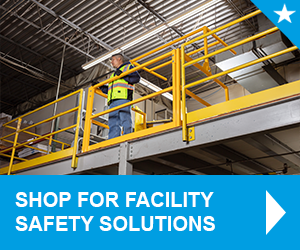
American oil and gas refineries are anticipating increased demand in 2024, giving safety managers at those facilities greater need to fulfill work safety and compliance requirements. Compared to virtually any other general industry, OSHA requirements for fall protection and overall oil refinery safety are much more nuanced, due to the interplay of:
- Elevated platforms
- Confined spaces
- Mezzanines and storage areas
- Dangerous machinery
- Chemical and explosive hazards
- Interior-exterior transition points
- High-capacity shipping and receiving areas
Yet no matter how nuanced oil refinery safety requirements become, facility owners and their safety managers must always address stringent safety requirements. Fortunately, modern innovations in adaptable self-closing platform gates can meet and surpass a vast range of fall safety requirements – and even improve efficiency.
Streamlined Workflows Directly Translate to Greater Safety
Most oil and gas facilities make extensive use of elevated platforms and mezzanines, both to conserve valuable floor space and streamline busy workflows. This often places dangerous equipment, material and chemical storage, piping and conduit, and other hazards in proximity. Workers also face risk of falling object hazards, even when their own work doesn’t place them directly onto walking-working surfaces.
What it all requires, from a work safety standpoint, is nothing less than the leading edge in technically innovative fall protection systems. In fact, such devices can even streamline intersecting work functions by controlling access. Oil and gas operations at any scale can fulfill the widest range of OSHA requirements for fall protection by investing in self-closing platform gates designed for the most common industry regulations.
In other words, oil refinery safety standards may be complex; but your safety equipment should be anything but.
Hands-Free Accessibility
More than any industry, oil and gas refineries are characterized by extensive networks of walking-working platforms. Here, self-closing platform gates fulfill numerous fall protection functions, including:
- Controlling traffic at busy loading docks
- Keeping manual laborers and industrial vehicles from crossing paths
- Designating and preventing unauthorized entry to restricted areas
- Providing accessibility while meeting the same protection standards as OSHA-compliant handrails in various locations, including:
- Ladder and stairway entrances
- Dangerous machinery requiring periodic access
- Uneven surfaces
- Rooftop access points, including hatches and exterior stairways
Self-closing gates aren’t always just value-adding options, to be used at the safety manager’s discretion. Since 2017, there have been several self-closing gate requirements for conditions common to oil and gas facilities:
- OSHA 1910.29(b)(13)(i) specifically requires a self-closing gate at ladderways and other such access points. Note the gate must open away from the entry point, which makes universal-mount safety gates ideal.
- Unless there’s a surrounding wall or parapet at least 21 in. (53 cm) high, per subsection (b)(2), the self-closing gate must heed further design standards:
- Subsection (b)(2)(i) requires midrails halfway between the walking-working surface and the top edge of the surrounding guardrail system.
- Both subsections (b)(2)(iii) and (iv) require vertical members or equivalents (e.g., architectural panels), leaving no more than 19 in. (48 cm) of space.
Note that you must further cross-reference a host of additional safety requirements any time your oil and gas facility engages in construction work. Whenever anticipated maintenance gives way to more significant upgrades or repairs, OSHA 1926 Subpart M takes full effect, which covers additional requirements for guardrails (particularly, subsection [b]).
Thus, it’s important to thoroughly consult your specific OSHA and CCOHS requirements as operational needs change – for which modular, easily adaptable guardrails and swing gates can more quickly fulfill the widest possible range of safety requirements.
Comprehensive Compliance Through Choice Equipment Investments
As complex as it all sounds, it’s possible to fulfill all or most of your accessibility and fall protection requirements with one of many value-adding design features:
- Full coverage safety gates, which provide the added benefit of toeguarding beyond basic requirements (i.e., 1910.28[b][3][iv] allows one exposed edge at the opening; but even this is hardly necessary with full coverage gates).
- Extended coverage safety gates, with additional cross members – useful in supporting safer ladder ingress/egress (just be sure the gate itself is less than 19 in. wide, or customized with intermediate members, if the application must comply with 1910.29[b][13][i]).
- Extended coverage Z-gates, which reduce the gate’s interior opening.
- Plated swing gates, which fulfill the intermediate member (or equivalent) requirements discussed above in the simplest possible way.
Hinge-Side, Positive-Stop Closing Mechanisms
As for the self-closing mechanism, the most versatile design is one that provides its own stopping force without needing to contact the railing. This is the case with traditional self-closing gate designs, which require a plate at the outermost edge of the gate. Yet this renders the self-closing feature inadequate if the application lacks an adjacent vertical post or baluster (a common situation for ladder and stairways next to walls).
More innovative self-closing gates feature a positive-stop mechanism entirely on the hinge-side, for a fully self-contained platform gate capable of returning to its closed position, independent of its surroundings.
Facilitating Teamwork with Mezzanine Gates
Another defining aspect of oil refinery safety and workflows is that they both depend heavily on teamwork. Nowhere is this truer than mezzanines, where workers face multiple intersecting dangers during loading and unloading:
- Exposed leading edges
- Handling heavy palettes and other materials
- Use of industrial vehicles and/or motorized hoisting equipment
- Greater risk of falling object hazards, just when workers are along the same vertical plane
- The need to manipulate complex gate systems
From a work safety standpoint, the goal is to resolve most safety risks with more innovative passive fall protection strategies. Dual, self-closing mezzanine gates, for example, prevent the main cause of all the previously mentioned safety risks: unguarded access to leading edges before heavy loads are fully secured.
Yet with a precisely counterbalanced two-part gate design, workers above and below receive protection just when fall hazards are most acute. To wit:
- The outermost mezzanine gate opens only when the innermost gate is closed, allowing forklift or hoist operators to position the payload in the receiving area
- When the inner gate opens, the outermost gate automatically closes, ensuring upper-level employees are never exposed to an unguarded leading edge
Fabenco: Meeting Complexity with Innovation
OSHA requirements for fall protection can be complex in even the simplest general industry settings. Without the right strategy, backed by advanced technical solutions, meeting refinery safety requirements can result in even greater complexity.
Don’t chance oil facility safety with subpar, efficiency-draining safety equipment. By selecting adaptable, self-closing platform gates, you can vastly improve your fall safety at ladder/stairways, mezzanines, and countless other critical access points.
Enhance your refinery’s fall protection strategy with a fall protection manufacturer versed in modular railing and safety gates, backed by decades of multi-industry experience. Contact Fabenco to fulfill your oil refinery work safety needs and make much shorter work of increasing compliance and workflow dependencies alike.





